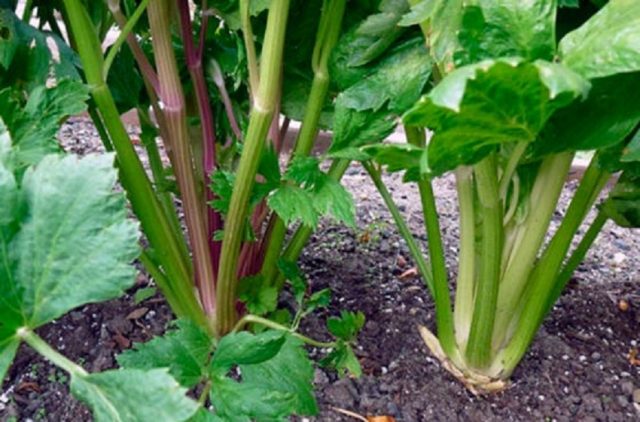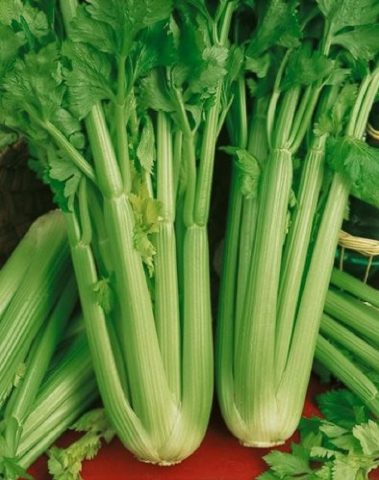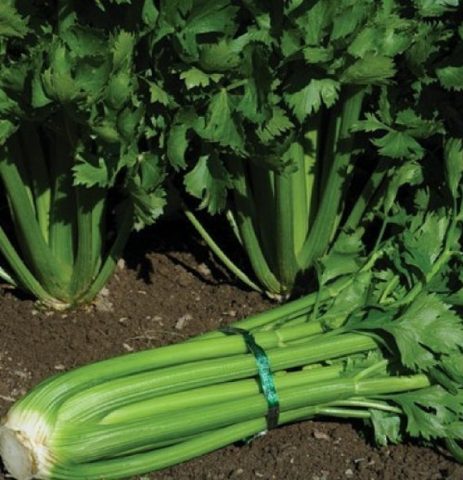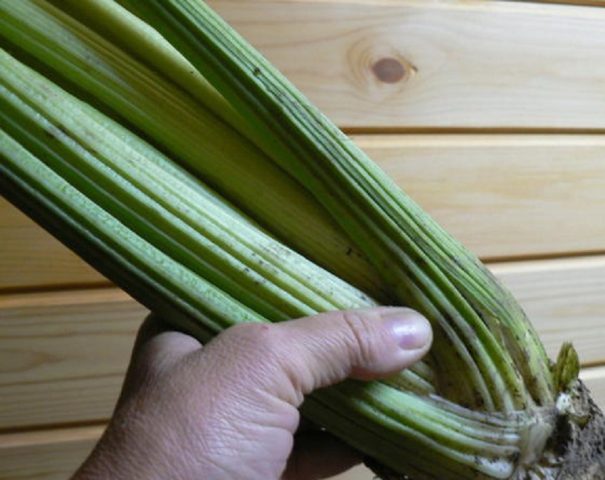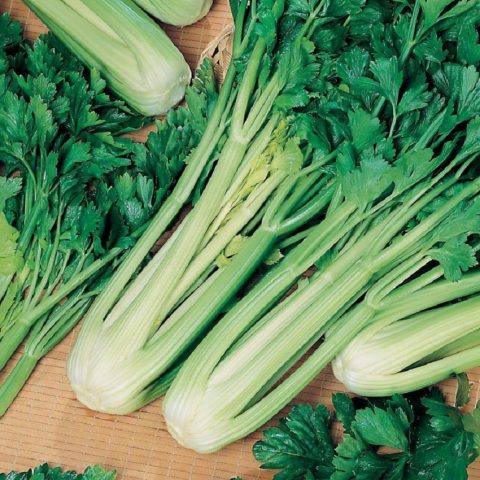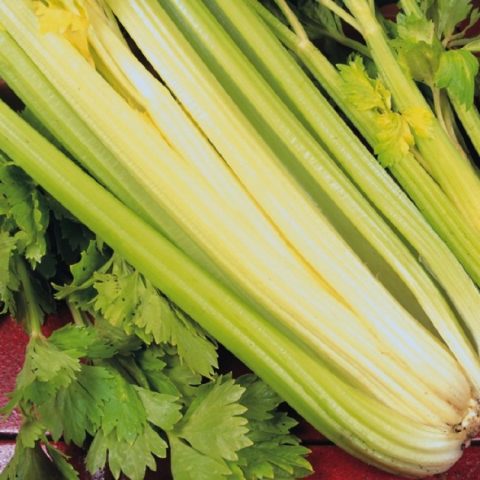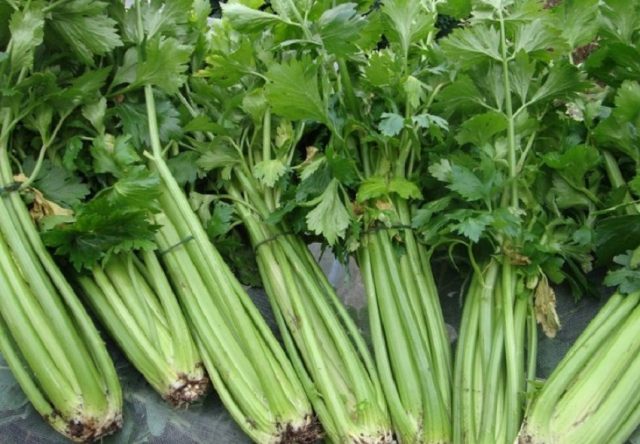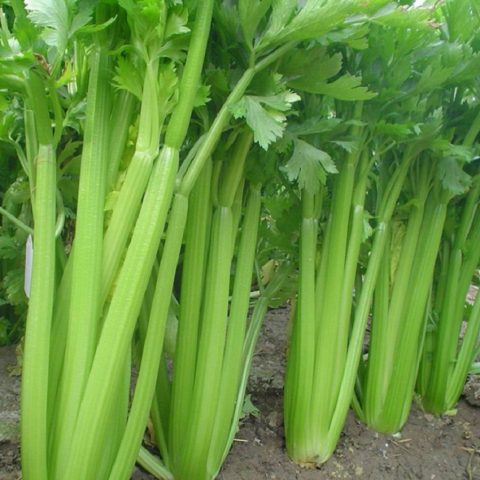Content
There are several varieties of celery. The classification is made according to the parts of the plant that are eaten. The culture is quite well-known, but the petiole varieties are not very popular. The following are descriptions of varieties and photos of stalked celery.
Variety of varieties of stalked celery
In this species, the stems are used for food, therefore it is sometimes called the stem. It does not form a pronounced tuber, the root system consists of fibrous, well-developed roots. Stalked celery forms fleshy, juicy stems in the first year of cultivation. It is at this time that they need to be cut off. If celery is not harvested in time, tough fibers will form in the stems. Petiolate species prefer nutritious, loose soil. On poor land, the grower will receive thin, weak petioles. Also, areas with strong lighting are not suitable for them; it is better to allocate slightly shaded places for planting, for example, under trees. In the second year, the plant produces flower stalks. The varieties become over-pollinated and lose their pronounced characteristics. Therefore, in the second year, the beds should be separated by a sufficient distance. Petioles are used not only in cooking, but also in cosmetology, recipes for traditional medicine. The variety of varieties allows you to prepare dishes with different tastes and aromas. To be convinced of the benefits of culture, it is enough to list the beneficial components:
- B vitamins;
- mineral salts;
- essential oils;
- carotene;
- vitamin C;
- flavonoids;
- magnesium, potassium, iron, sodium.
This is an incomplete list of substances that provide invaluable benefits to the human body. Culinary experts not only stew and pickle the petioles, but also freeze, pickle, prepare juice or cocktails. The stems of the vegetable contain fiber, which is slowly digested, creating a long-lasting feeling of satiety.
Petiolate species should be carefully used by people with problems of the genitourinary system and expectant mothers.
The best varieties of stalked celery
Stem varieties are divided into subgroups:
- Self-bleaching... These are types that do not need additional whitening. During the growing season, they are able to form a full-fledged stem.
- Green... Varieties requiring a bleaching period. This is the time to improve the quality of the stems. 2 weeks before harvesting, the petioles are wrapped in paper so that sunlight does not come in. Leaves are left in the light.
Celery is grown in two ways - seedling and sowing in the ground. The choice is carried out based on the duration of the formation of the stems. Therefore, before sowing celery, you should carefully read the description of the variety and the ripening time of the petioles.
Celery stalked Atlant
Refers to mid-season species. Technical ripeness occurs 160-170 days after germination. The variety is distinguished by an upright rosette 45 cm high and 50 cm in diameter. The leaves are green, medium-sized, with a high gloss. Petioles are green with a slightly ribbed surface. Up to 400 g of juicy petioles are harvested from one plant. Productivity 2.7-3.2 kg per 1 sq. m of landing area. It is grown in seedlings and requires additional bleaching. Culinary experts are happy to use the variety fresh or canned.According to consumer reviews, Atlant petiole celery is very good as a spice.
Celery stalked Sail
Another mid-season species. The period from the emergence of sprouts to technical ripeness is 75-80 days. It has a semi-vertical rosette of leaves, the height of an adult plant is 55 cm, diameter is 40 cm, weight is up to 1 kg. The color of the petioles is dark green, the length of one reaches 35 cm. The length of the petiole used for food is 20 cm. It is most often used in cooking as a seasoning. It is grown in seedlings due to the length of the growing season.
- Seeds for seedlings are sown at the end of February with a depth of 0.5 cm.
- Dive at the stage of the first true leaf.
- They are transplanted into the ground in late May or early June, depending on weather conditions. At this point, the seedlings should be 60-80 days old.
Petioles are used fresh and dried.
Celery stalked Pascal
Mid-season species with an erect leaf rosette. The crop is ready to litter 12-14 weeks after germination. The petioles are powerful, the width of one at the base is 4.5 cm, the length is up to 30 cm, the color is light green. The weight of one rosette is about 0.5 kg, up to 20 stems per plant. It is grown in seedlings in the greenhouse and in the open field. Requires regular hilling to obtain bleached stems. Loves organic fertilizing - ash, humus. The yield is high - up to 5 kg per 1 sq. m.
Male prowess
Late-ripening species, harvesting occurs 150-169 days after germination. The color of the petioles is light green, the shape is almost even, slightly curved and slightly ribbed. Erect leaf rosette, weighing 850 g, about 79 cm high, consists of 15 leaves. The stem length is up to 55 cm, the yield of the variety is 3.3-3.8 kg per 1 sq. m. Petioles gain weight up to 650 g, require bleaching. It is used fresh and for cooking hot meals.
Triumph
It enters technical ripeness 125 days after germination. Plant height 65 cm. The rosette is compact, the petioles are juicy, distinguished by fleshy pulp, persistent aroma, the color is dark green. The greens grow back very quickly after cutting. Grown in open ground and greenhouses.
Crunch
Harvesting begins 120 days after seed germination. The rosette forms a vertical, 45 cm high, compact. The stems are dark green, juicy, with a pleasant persistent aroma. The yield of the variety is 3.0-3.2 kg per 1 sq. m. It is appreciated for its resistance to low temperatures.
Utah
Harvesting time comes after 170-180 days. Variety with a vertical rosette of leaves 65 cm high. Petioles without fibers, long, curved from the inside. The color is dark green. Grown in seedlings, sowing seeds is carried out in March. Utah's yield is 3.7 kg per sq. m, the weight of one plant is about 350 g. It has a persistent pleasant aroma, good keeping quality and taste characteristics.
Self-bleaching varieties of stalked celery
In addition to green varieties, many self-bleaching types of petiole celery have been bred. They do not require a bleaching period, but are less spicy and less crisp. Growing a self-bleaching vegetable is a little easier, but these varieties can't stand a cold snap. You need to harvest before the frosty days. Gardeners dig up self-bleaching species gradually and selectively, trying not to damage nearby growing plants.
Gold
The crop is ready for harvest 160 days after the first shoots appear. The variety is considered the leader among self-bleaching species in terms of its characteristics. It has stems of medium length with slight curvature and ribbing. The color of the petioles is light green with a slight yellowing. The weight of one outlet is about 850 g. The variety is very productive, with a good agricultural background with 1 sq. M. m collect up to 5 kg of petioles. It is considered a very advantageous view. It is used in cooking as a vegetable component and a spice, although the variety is slightly hot.
Malachite
The ripening period is shorter than that of the previous variety.Petioles are ready to harvest in 90-100 days. Forms a rosette weighing 1.2 kg. Malachite's stems are fleshy, dense, slightly curved. When ripe, it is dark green in color. The surface of the petioles is slightly ribbed. Malachite is a variety with a high yield among the varieties of stalked celery. From 1 sq. m of area, up to 4 kg of high-quality stems with a length of 35 cm are harvested.
Tango
It is considered one of the best self-bleaching types of stalked celery. Harvested after 160-180 days from the date of emergence. Forms petioles of the original bluish-green color, 50 cm long. The inner mass of the stems does not contain coarse fibers. From the outside, they are straight, and from the inside, they are strongly curved. Leaves are small, light green in color. The socket weighs about 1 kg. Among farmers, it is valued for a pleasant persistent aroma, good taste, the ability to store for a long time and resistance to flowers and rust. The yield is up to 3.7 kg per 1 sq. m.
Conclusion
With the help of the proposed description and photo of stalked celery, it will be easy to choose a suitable variety for growing. Novice growers should plant several different varieties to determine the difference and choose the best one.
